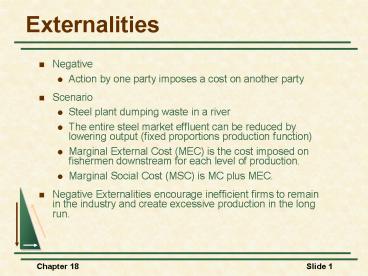Externalities - PowerPoint PPT Presentation
1 / 15
Title:
Externalities
Description:
Externalities Negative Action by one party imposes a cost on another party Scenario Steel plant dumping waste in a river The entire steel market effluent can be ... – PowerPoint PPT presentation
Number of Views:51
Avg rating:3.0/5.0
Title: Externalities
1
Externalities
- Negative
- Action by one party imposes a cost on another
party - Scenario
- Steel plant dumping waste in a river
- The entire steel market effluent can be reduced
by lowering output (fixed proportions production
function) - Marginal External Cost (MEC) is the cost imposed
on fishermen downstream for each level of
production. - Marginal Social Cost (MSC) is MC plus MEC.
- Negative Externalities encourage inefficient
firms to remain in the industry and create
excessive production in the long run.
2
External Costs
Price
Price
Industry output
Firm output
3
The Efficient Level of Emissions
Assume 1) Competitive market 2) Output and
emissions decisions are independent 3) Profit
maximizing output chosen
Dollars per unit of Emissions
6
Why is this more efficient than zero emissions?
4
2
0
2
4
6
8
10
12
14
16
18
20
22
24
26
Level of Emissions
4
Ways of Correcting Market Failure
- Options for Reducing Emissions to E
- Emission Standard Set a legal limit on emissions
at E (12) which increases the cost of production
and the threshold price to enter the industry.
Enforced by monetary and criminal penalties. - Emissions Fee Charge levied on each unit of
emission. - Assumptions
- Policymakers have asymmetric information
- Administrative costs require the same fee or
standard for all firms
5
The Case for Fees
Fee per Unit of Emissions
6
The cost minimizing solution would be an
abatement of 6 for firm 1 and 8 for firm 2
and MCA1 MCA2 3.
5
4
3
2
1
Level of Emissions
0
1
2
3
4
5
6
7
8
9
10
11
12
13
14
6
The Case for Standards
Fee per Unit of Emissions
16
14
12
10
8
6
4
2
0
2
4
6
8
10
12
Level of Emissions
14
16
7
Ways of Correcting Market Failure
- Advantages of Fees
- When equal standards must be used, fees achieve
the same emission abatement at lower cost. - Fees create an incentive to install equipment
that would reduce emissions further. - Summary Fees vs. Standards
- Standards are preferred when MSC is steep and MCA
is flat. - Standards (incomplete information) yield more
certainty on emission levels and less certainty
on the cost of abatement. - Fees have certainty on cost and uncertainty on
emissions. - Preferred policy depends on the nature of
uncertainty and the slopes of the cost curves.
8
Ways of Correcting Market Failure
- Transferable Emissions Permits
- Permits help develop a competitive market for
externalities. - Agency determines the level of emissions and
number of permits - Permits are marketable
- High cost firm will purchase permits from low
cost firms
9
Externalities and Property Rights
- Property Rights
- Legal rules describing what people or firms may
do with their property - For example If residents downstream owned the
river (clean water) they control upstream
emissions. - Bargaining and Economic Efficiency
- Economic efficiency can be achieved without
government intervention when the externality
affects relatively few parties and when property
rights are well specified. - Coase Theorem
- When parties can bargain without cost and to
their mutual advantage, the resulting outcome
will be efficient, regardless of how the property
rights are specified.
10
Example Bargaining with Alternative Property
Rights Fishermen and a Factory!
Right to Dump Right to Clean Water
- No Cooperation
- Profit of factory 500 300
- Profit of fishermen 200 500
- Cooperation
- Profit of factory 550 300
- Profit of fishermen 250 500
11
Externalities and Property Rights
- Costly Bargaining - The Role of Strategic
Behavior - Bargaining requires clearly defined rules and
property rights. - A Legal Solution - Suing for Damages
- Fishermen have the right to clean water
- Factory has two options
- No filter, pay damages
- Profit 100 (500 - 400)
- Filter, no damages
- Profit 300 (500 - 200)
12
Externalities and Property Rights
- A Legal Solution - Suing for Damages
- Factory has the right to emit effluent
- Fishermen have three options
- Put in treatment plant
- Profit 200
- Filter and pay damages
- Profit 300 (500 - 200)
- No plant, no filter
- Profit 100
- Conclusion A suit for damages results in an
efficient outcome. - Question How would imperfect information impact
the outcome?
13
Common Property Resources
- Common Property Resource
- Everyone has free access.
- Likely to be overutilized
- Examples Air and water Fish and animal
populations - Solution Private ownership
- Question When would private ownership be
impractical?
14
Common Property Resources
Benefits, Costs ( per fish)
Fish per Month
15
Public Goods
- Public Good Characteristics
- Nonrival For any given level of production the
marginal cost of providing it to an additional
consumer is zero. - Nonexclusive People cannot be excluded from
consuming the good. - Free Riders enjoy the benefit of a good or
service without paying for it.































